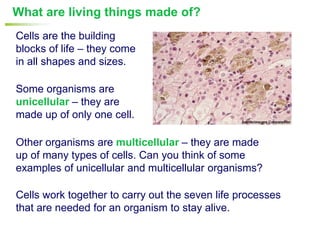More Related Content
What's hot
What's hot (20)
Biology unit 4 cell division cell division basics and the cell cycle notes

Biology unit 4 cell division cell division basics and the cell cycle notes
Viewers also liked
Viewers also liked (11)
Presentación EY y MRE - Guías de negocios e inversión 2015-2016

Presentación EY y MRE - Guías de negocios e inversión 2015-2016
More from Shaun Hutch
1
- 1. What are living things made of? Cells are the building blocks of life – they come in all shapes and sizes. Some organisms are unicellular – they are made up of only one cell. Other organisms are multicellular – they are made up of many types of cells. Can you think of some examples of unicellular and multicellular organisms? Cells work together to carry out the seven life processes that are needed for an organism to stay alive.

